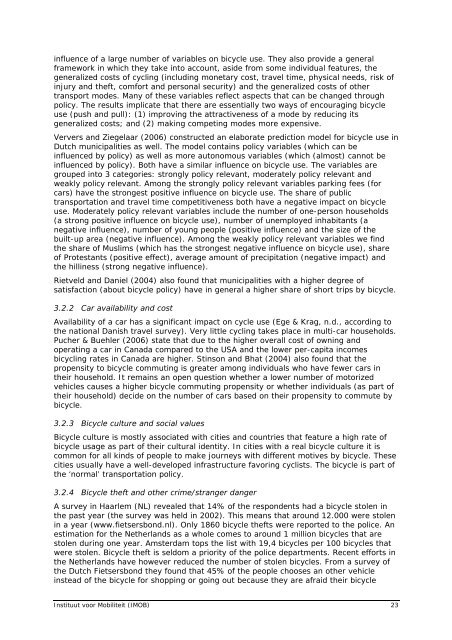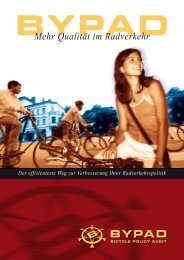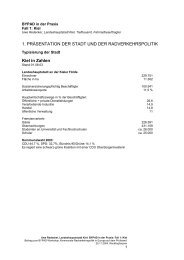Annex I: Literature search bicycle use and influencing ... - ByPAD
Annex I: Literature search bicycle use and influencing ... - ByPAD
Annex I: Literature search bicycle use and influencing ... - ByPAD
Create successful ePaper yourself
Turn your PDF publications into a flip-book with our unique Google optimized e-Paper software.
influence of a large number of variables on <strong>bicycle</strong> <strong>use</strong>. They also provide a general<br />
framework in which they take into account, aside from some individual features, the<br />
generalized costs of cycling (including monetary cost, travel time, physical needs, risk of<br />
injury <strong>and</strong> theft, comfort <strong>and</strong> personal security) <strong>and</strong> the generalized costs of other<br />
transport modes. Many of these variables reflect aspects that can be changed through<br />
policy. The results implicate that there are essentially two ways of encouraging <strong>bicycle</strong><br />
<strong>use</strong> (push <strong>and</strong> pull): (1) improving the attractiveness of a mode by reducing its<br />
generalized costs; <strong>and</strong> (2) making competing modes more expensive.<br />
Ververs <strong>and</strong> Ziegelaar (2006) constructed an elaborate prediction model for <strong>bicycle</strong> <strong>use</strong> in<br />
Dutch municipalities as well. The model contains policy variables (which can be<br />
influenced by policy) as well as more autonomous variables (which (almost) cannot be<br />
influenced by policy). Both have a similar influence on <strong>bicycle</strong> <strong>use</strong>. The variables are<br />
grouped into 3 categories: strongly policy relevant, moderately policy relevant <strong>and</strong><br />
weakly policy relevant. Among the strongly policy relevant variables parking fees (for<br />
cars) have the strongest positive influence on <strong>bicycle</strong> <strong>use</strong>. The share of public<br />
transportation <strong>and</strong> travel time competitiveness both have a negative impact on <strong>bicycle</strong><br />
<strong>use</strong>. Moderately policy relevant variables include the number of one-person ho<strong>use</strong>holds<br />
(a strong positive influence on <strong>bicycle</strong> <strong>use</strong>), number of unemployed inhabitants (a<br />
negative influence), number of young people (positive influence) <strong>and</strong> the size of the<br />
built-up area (negative influence). Among the weakly policy relevant variables we find<br />
the share of Muslims (which has the strongest negative influence on <strong>bicycle</strong> <strong>use</strong>), share<br />
of Protestants (positive effect), average amount of precipitation (negative impact) <strong>and</strong><br />
the hilliness (strong negative influence).<br />
Rietveld <strong>and</strong> Daniel (2004) also found that municipalities with a higher degree of<br />
satisfaction (about <strong>bicycle</strong> policy) have in general a higher share of short trips by <strong>bicycle</strong>.<br />
3.2.2 Car availability <strong>and</strong> cost<br />
Availability of a car has a significant impact on cycle <strong>use</strong> (Ege & Krag, n.d., according to<br />
the national Danish travel survey). Very little cycling takes place in multi-car ho<strong>use</strong>holds.<br />
Pucher & Buehler (2006) state that due to the higher overall cost of owning <strong>and</strong><br />
operating a car in Canada compared to the USA <strong>and</strong> the lower per-capita incomes<br />
bicycling rates in Canada are higher. Stinson <strong>and</strong> Bhat (2004) also found that the<br />
propensity to <strong>bicycle</strong> commuting is greater among individuals who have fewer cars in<br />
their ho<strong>use</strong>hold. It remains an open question whether a lower number of motorized<br />
vehicles ca<strong>use</strong>s a higher <strong>bicycle</strong> commuting propensity or whether individuals (as part of<br />
their ho<strong>use</strong>hold) decide on the number of cars based on their propensity to commute by<br />
<strong>bicycle</strong>.<br />
3.2.3 Bicycle culture <strong>and</strong> social values<br />
Bicycle culture is mostly associated with cities <strong>and</strong> countries that feature a high rate of<br />
<strong>bicycle</strong> usage as part of their cultural identity. In cities with a real <strong>bicycle</strong> culture it is<br />
common for all kinds of people to make journeys with different motives by <strong>bicycle</strong>. These<br />
cities usually have a well-developed infrastructure favoring cyclists. The <strong>bicycle</strong> is part of<br />
the ‘normal’ transportation policy.<br />
3.2.4 Bicycle theft <strong>and</strong> other crime/stranger danger<br />
A survey in Haarlem (NL) revealed that 14% of the respondents had a <strong>bicycle</strong> stolen in<br />
the past year (the survey was held in 2002). This means that around 12.000 were stolen<br />
in a year (www.fietsersbond.nl). Only 1860 <strong>bicycle</strong> thefts were reported to the police. An<br />
estimation for the Netherl<strong>and</strong>s as a whole comes to around 1 million <strong>bicycle</strong>s that are<br />
stolen during one year. Amsterdam tops the list with 19,4 <strong>bicycle</strong>s per 100 <strong>bicycle</strong>s that<br />
were stolen. Bicycle theft is seldom a priority of the police departments. Recent efforts in<br />
the Netherl<strong>and</strong>s have however reduced the number of stolen <strong>bicycle</strong>s. From a survey of<br />
the Dutch Fietsersbond they found that 45% of the people chooses an other vehicle<br />
instead of the <strong>bicycle</strong> for shopping or going out beca<strong>use</strong> they are afraid their <strong>bicycle</strong><br />
Instituut voor Mobiliteit (IMOB) 23




